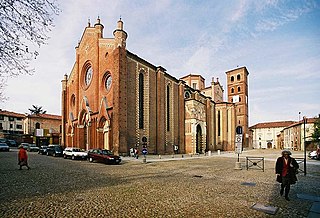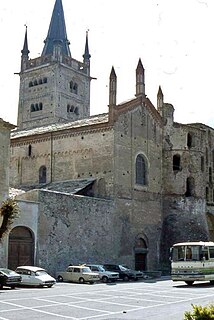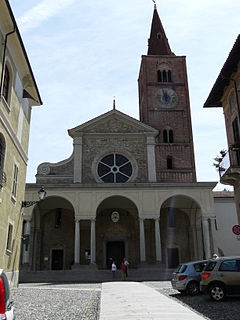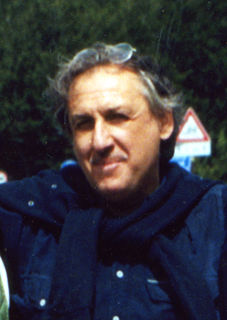Related Research Articles

Sant'Ambrogio di Torino is a comune (municipality) in the Metropolitan City of Turin in the Italian region Piedmont, located about 25 km west of Turin in the Susa Valley.

The Diocese of Saluzzo is a Catholic ecclesiastical territory in the Piedmont region of northwestern Italy, centered in the comune of Saluzzo. The diocese was established on 29 October 1511, and was directly dependent upon the Holy See. It is now a suffragan of the Archdiocese of Turin.

The Roman Catholic Archdiocese of Turin is an ecclesiastical territory or diocese of the Roman Catholic Church in Italy.
Ulric Manfred II or Manfred Ulric was the count of Turin and marquis of Susa in the early 11th century. He was the last male margrave from the Arduinid dynasty. Ulric Manfred's daughter, Adelaide, inherited the majority of his property. Through marriage to Adelaide (c.1045), Otto of Savoy, a younger son of Count Humbert I of Savoy became margrave of Turin. Their descendants would later comprise the House of Savoy who ruled Sardinia and Italy.

Adelaide of Turin was the countess of part of the March of Ivrea and the marchioness of Turin in Northwestern Italy from 1034 to her death. She was the last of the Arduinici. She is sometimes compared to her second cousin, and close contemporary, Matilda of Tuscany.

The Diocese of Asti is a Roman Catholic ecclesiastical territory in Piedmont, northern Italy, centered in the city of Asti. It has been a suffragan of the Archdiocese of Turin since 1515. Previous to that, it was a suffragan of the Archdiocese of Milan.

The Roman Catholic Diocese of Susa, in Piedmont (Italy), was established in 1772. It is a suffragan of the archdiocese of Turin. The diocese and the city of Susa lie on the main route that leads to Italy from the Mont Cenis Pass and the Col de Montgenèvre.

The Roman Catholic Diocese of Acqui straddles the (civil) regions of Piedmont and Liguria, in northwest Italy. The ancient Roman name of the place was Aquae Statiellae, which was sometimes confused with Aquae Sentiae (Aix-en-Provence), and Aquae Augustae (Dax), where there were also bishops. Acqui had always been subordinate to the Province of Milan, down until 1817, when Pope Pius VII assigned it to the Province of Turin. As a suffragan of the Archdiocese of Turin, it falls within the ecclesiastical region of Piedmont.

The Diocese of Alessandria is a Roman Catholic ecclesiastical territory in Piedmont, northern Italy. It is a suffragan of the diocese of Vercelli.
Arnulf II was Archbishop of Milan from 998 to 1018.

Carlo Ilarione Petitti count of Roreto was an Italian economist, academic, writer, counsellor of state, and senator of the Kingdom of Sardinia. He is seen as a prominent figure in the Italian Risorgimento.

Michele Moramarco is an Italian author on Masonic ritual and history, a pop musician, and an advocate of Mazdean Christian Universalism. He leads a group of Italian Oddfellows, who started a revival of the procedures followed by the "Loyal Aristarcus Lodge" (1730-1740), the oldest ascertained Oddfellows' unit.
Cunibert of Turin was an Italian bishop. According to Anselm of Besate, Cunibert was a member of the Besate dynasty from Milan. Cunibert is first documented as bishop of Turin at the Council of Pavia. His episcopate lasted from then until his death, c.1082.
Andrea Della Corte was an Italian musicologist and critic. Born in Naples on 5 April 1883, Della Corte studied law at the University of the native city, but was self-taught in music. After some short experiences in Neapolitan papers, he moved to Turin, where he was music critic for La Stampa from 1919 to May 1967. He brought the music journalism in Italy to a level of «professionalism hitherto unknown». In Turin, Della Corte also taught history of music, both at the Conservatory (1926–53) and at the University (1939–53).
Alberto Basso is an Italian musicologist.
Landulf of Turin was an Italian bishop. He was bishop of Turin from 1011 until his death in 1037.
Gezo of Turin was an Italian bishop. He was bishop of Turin from 1000 until his death in 1011.
Guido of Turin was an Italian bishop. He was bishop of Turin from 1037 until his death in 1046.
Vitelmo of Turin or William of Turin was an Italian bishop. He was bishop of Turin from c.1082 until his death in 1092.
Mainard of Turin was an Italian bishop. He was bishop of Turin from 1100 until his death.
References
- F. Savio, Gli antichi vescovi d’Italia. Il Piemonte (Turin, 1899).
- G. Casiraghi, ‘Dal monte Pirchiriano alla cristianità: S. Michele della Chiusa e le sue dipendenze,’ in P. Cancian, G. Casiraghi, eds., Vicende, dipendenze e documenti dell’abbazia di S. Michele della Chiusa (Turin, 1993), pp. 14–22.
- T. Calchi, Rerum patriae seu Mediolanensis historiae libri XX (Milan, 1627).
- G.T. Terraneo, La principessa Adelaide contessa di Torino con nuovi documenti illustrata (Turin, 1759), 2 vols.
- G. Sergi, ‘Una grande circoscrizione del regno italico: la marca arduinica di Torino,’ Studi Medievali XII (1971), 637-712.